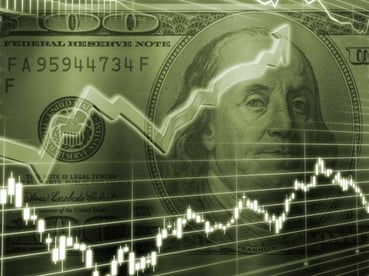
- Equities returns flat year-to-date through April
- Defensive sectors continue to struggle
- S&P 500 valuation more reasonable
- Higher interest rates still low
- Negative news flow to continue domination of fundamentals
Capital markets at best have been challenging for investment managers through the first four months of 2018. The NASDAQ continues to lead the broad domestic equity markets with a slightly positive return. Both the S&P 500 and Dow Jones Industrial Average have turned in slightly negative performance. Looking at the component sectors of the S&P 500 the more defensive sectors continue to turn in the poorest performance. Both Telecommunications and Consumer Staples are down over 10%. Returns on both Utilities and Health Care are also negative for the year though less so.
The better performing sectors continue to be Consumer Discretionary stocks and Information Technology which have advanced 5.09% and 3.24% respectively. Highly economically sensitive sectors – Industrials and Materials- are both down in the mid 5% range for the year.
The good news is that between the market correction, subsequent consolidation, and upwardly revised earnings estimates for the S&P 500 the market is more reasonably valued on a forward price/earnings multiple basis. The latest aggregate earnings estimate (per Argus) for S&P 500 earnings for 2018 is around $156 per share up from approximately $134 per share last year – or 16%. We are in the midst of Q1 earnings season and earnings results continue to impress. Over half of S&P 500 companies have reported and nearly 80% have exceeded estimate versus a norm in the low 70% range. In a nutshell, underlying fundamentals for equities domestically are healthy.
Foreign markets are mixed thus far in 2018 with Developed International markets declining just over 1%, and Emerging Market stocks posting a gain of 1.43%.
As has been the case for a while now Growth stocks continue to handily outperform Value issues by a wide margin across capitalization classes (Large, Mid, and Small). We believe this trend will continue given continued mediocre economic growth.
The driver of capital market action so far this year, in our view, is the fixed income markets. The specter of a pick up in inflation and economic growth in late January prompted the market correction. The yield on the benchmark 10-year Treasury has flirted with a 3% handle but to date hasn’t been able to stay above 3%. Subsequent economic data has held true to below normal inflation trends and decent -not extraordinary - economic growth.
Market consensus going into 2018 was that the 10-year Treasury yield would stay below 3%. While much media has been devoted to the rise in rates remember we are at incredibly low rates. Thus, even a healthy spike higher in rates keeps rates domestically relatively low. It is difficult to see a scenario in the short term in which rates would dictate a move towards bonds and away from equities in allocating portfolio assets. With the move higher in short term interest rates cash equivalents are yielding above 1% and currently provide a viable alternative to other fixed income classes. For the first four months of this year cash equivalents have provided the best returns (slightly positive) followed by high yield bonds (slightly negative).
Looking towards Memorial Day we believe market volatility will continue with the news flow from Washington dominating market fundamentals. Earnings should continue to be strong into next year though earnings growth should slow in 2019. Two to three more short term rate hikes are expected before year end. While the yield curve has flattened the spread between short term and long-term interest rates remain within reason from a recent historical context. Low long-term rates globally continue to be a headwind for long term rates moving higher domestically.
Major market returns year-to-date thru April were as follows:
S&P 500 -.96%
NASDAQ 2.36%
Dow Jones Industrial Average -2.25%
Barclay’s Aggregate Bond Index -2.19
High Yield Bonds -.21%
3 Month Treasury Bill .53%
MSCI EAFE (International Equity) -1.03%
Emerging Markets 1.43%











